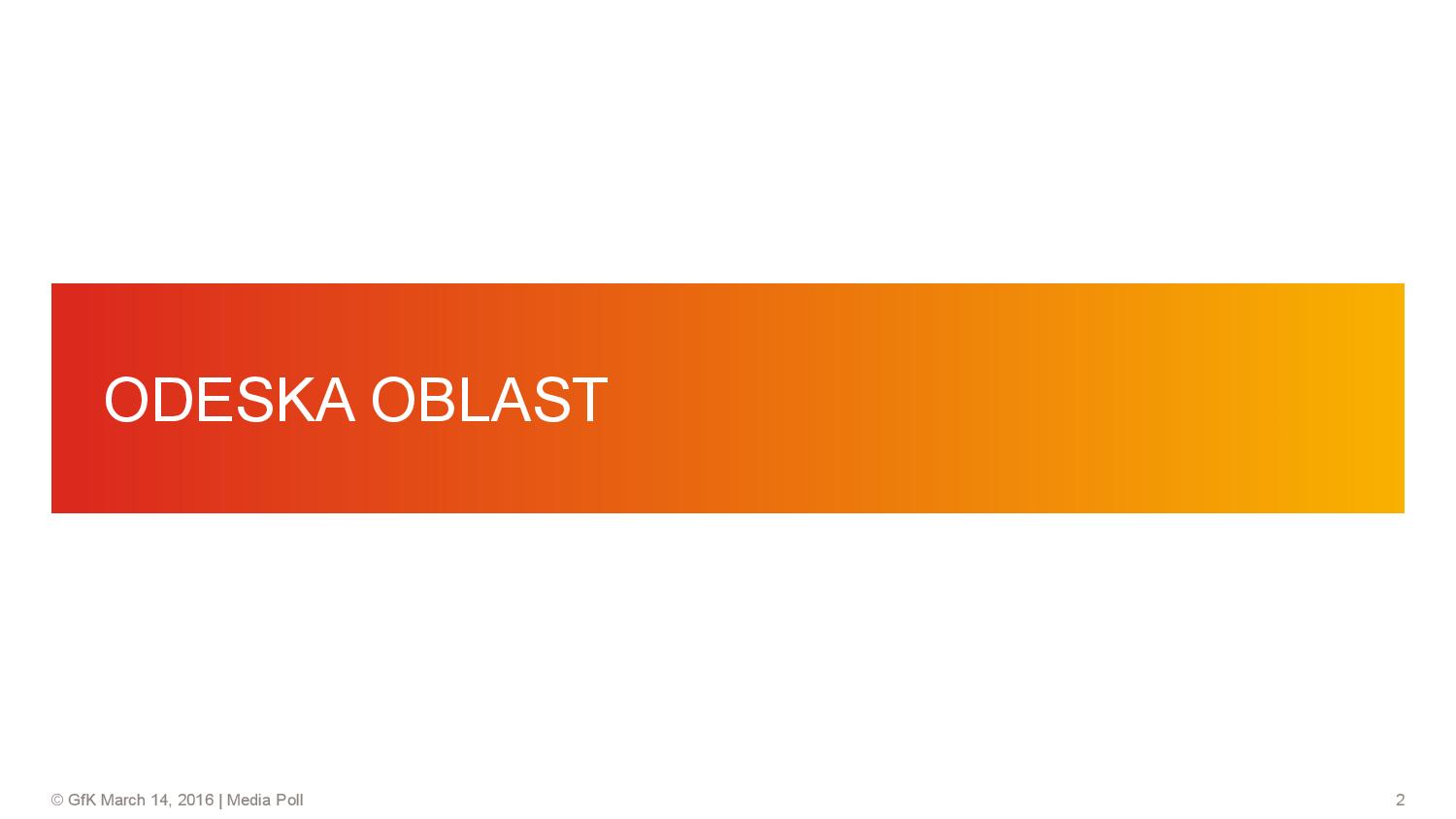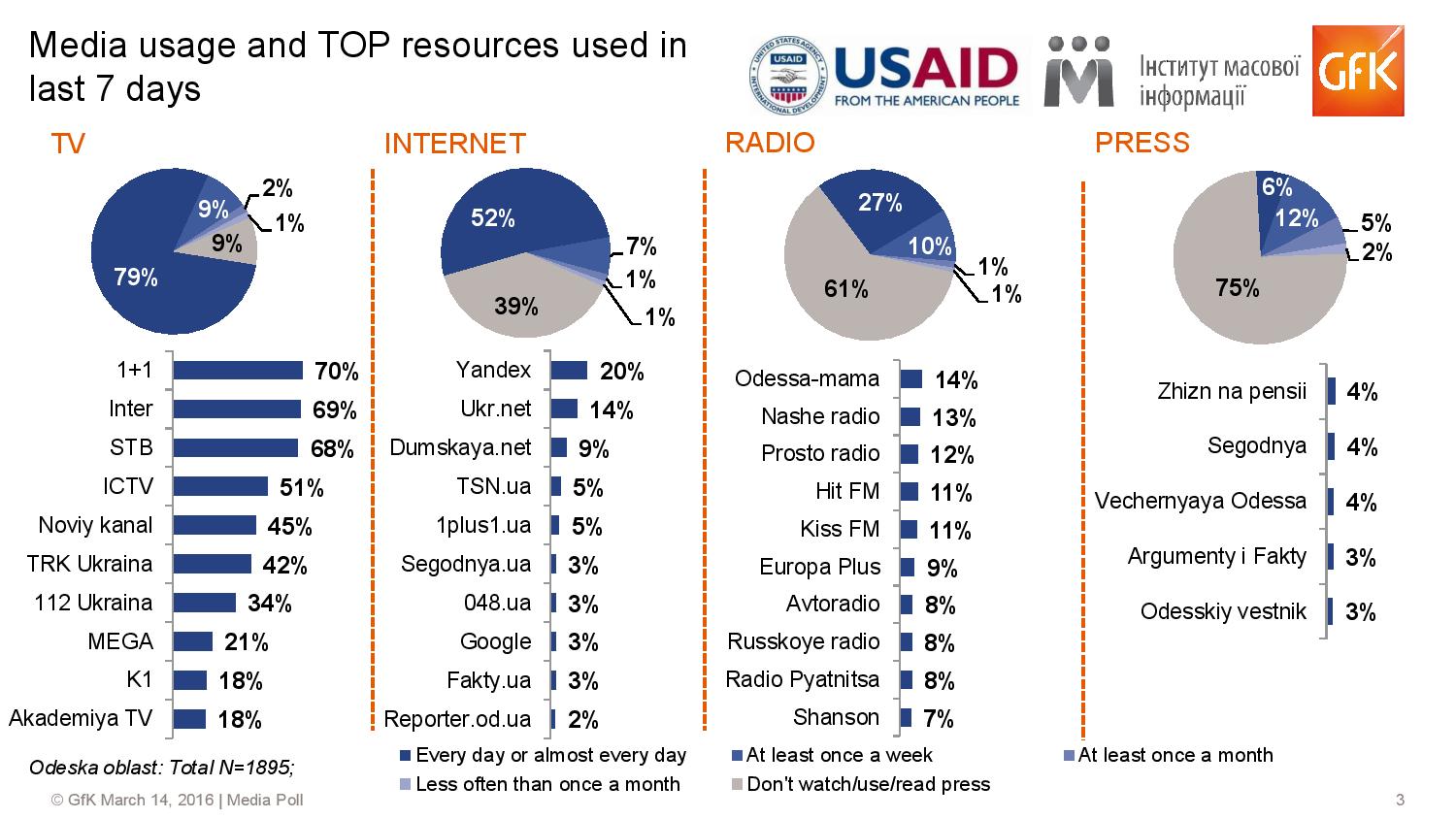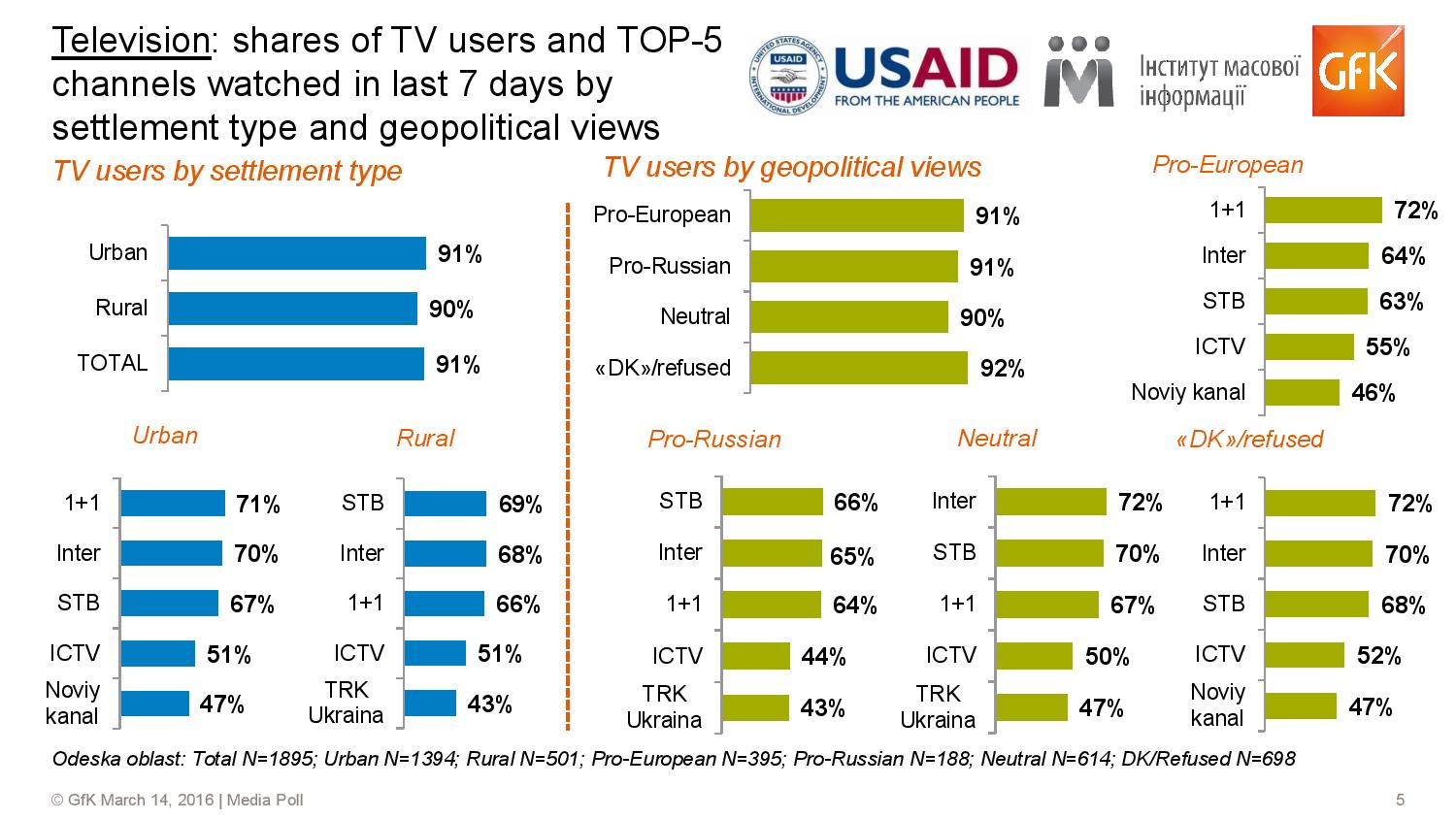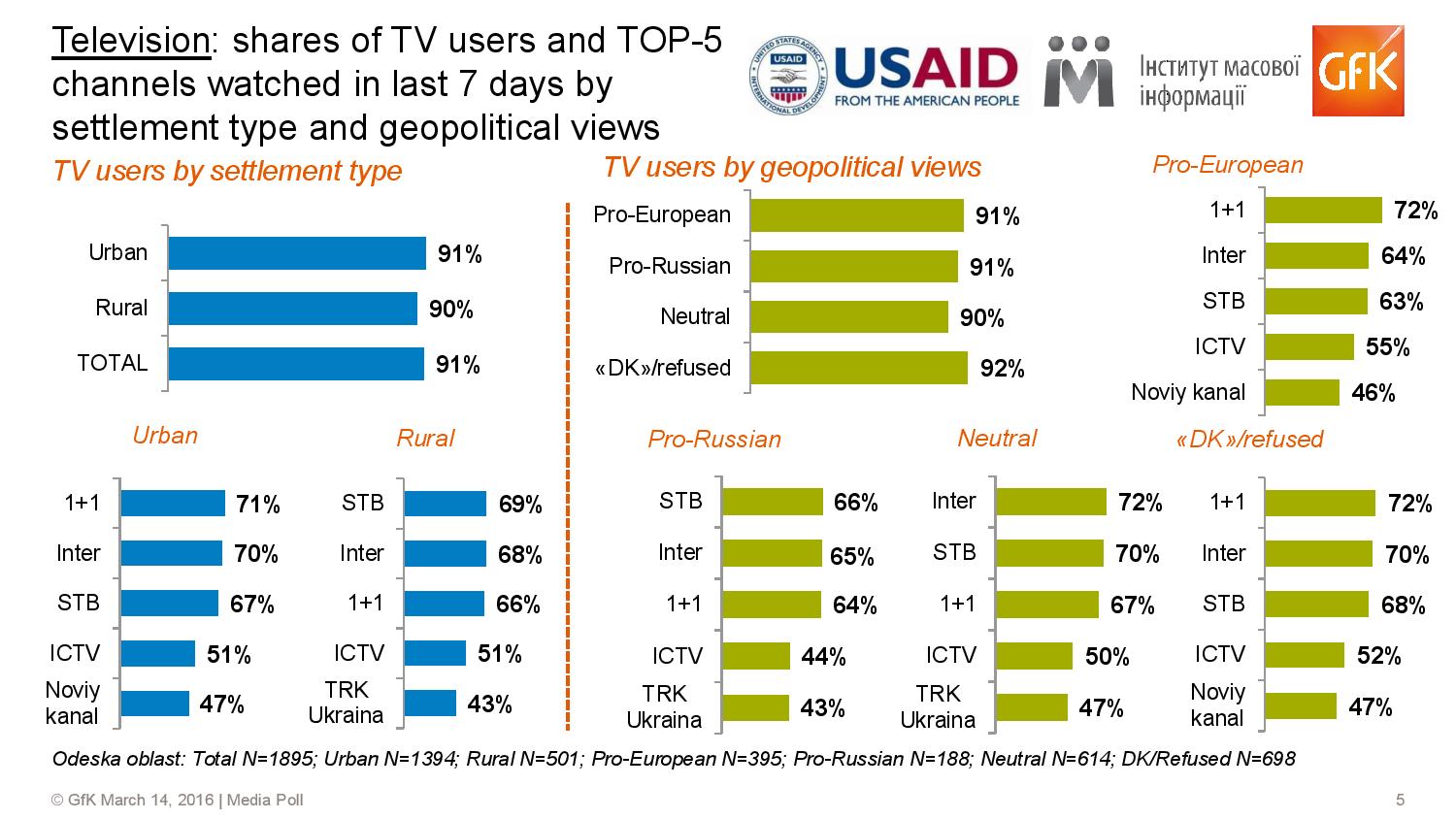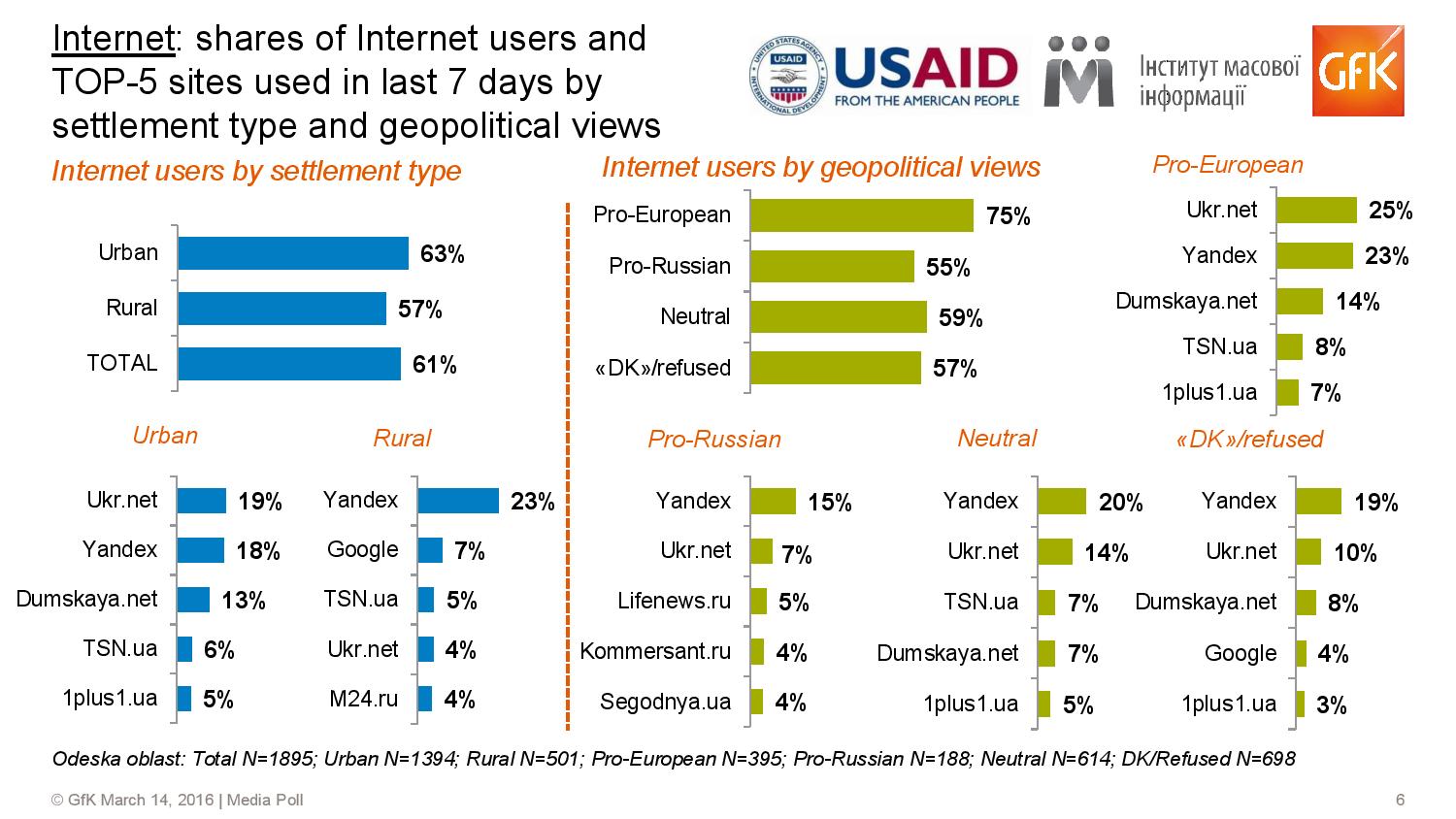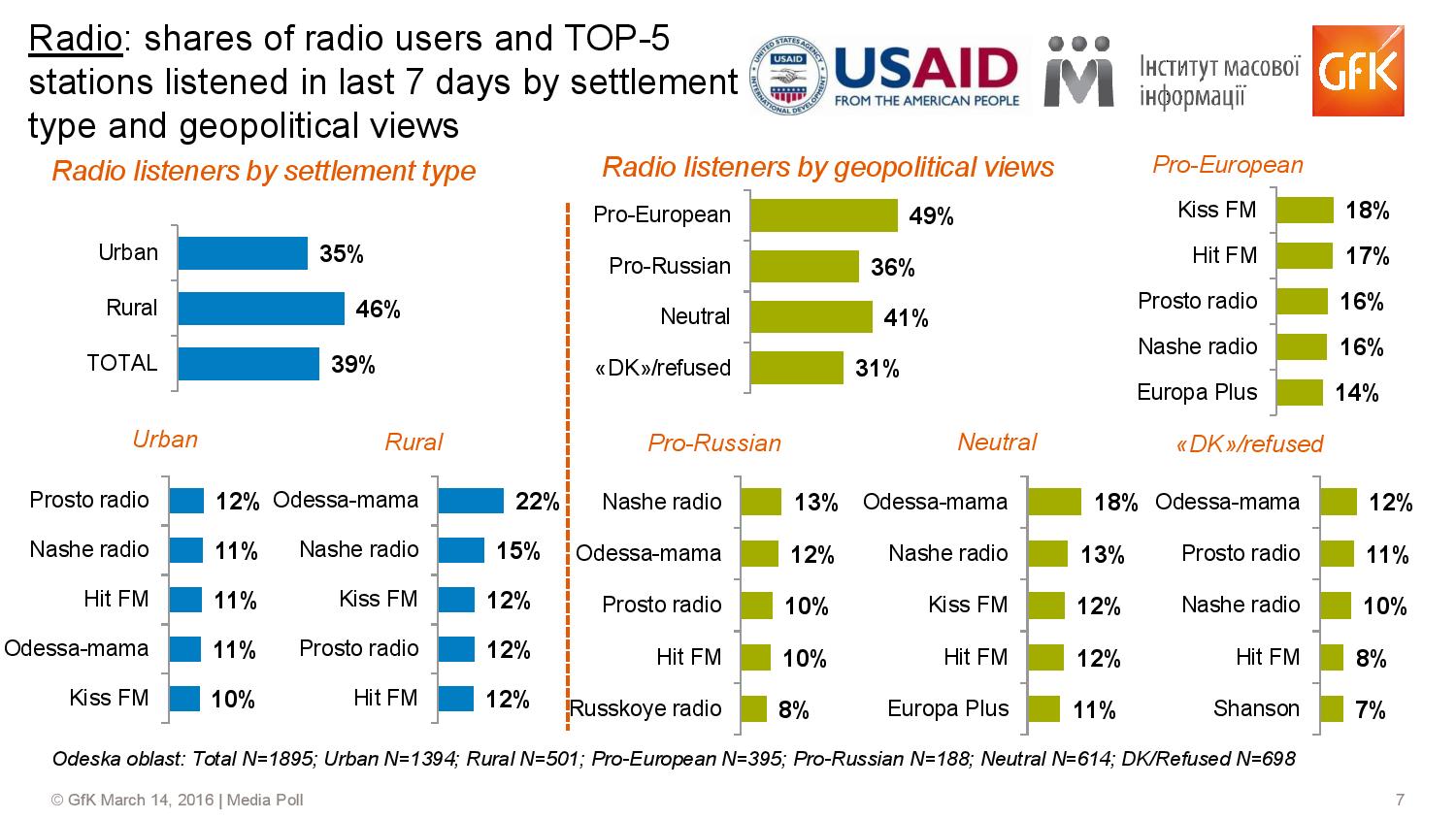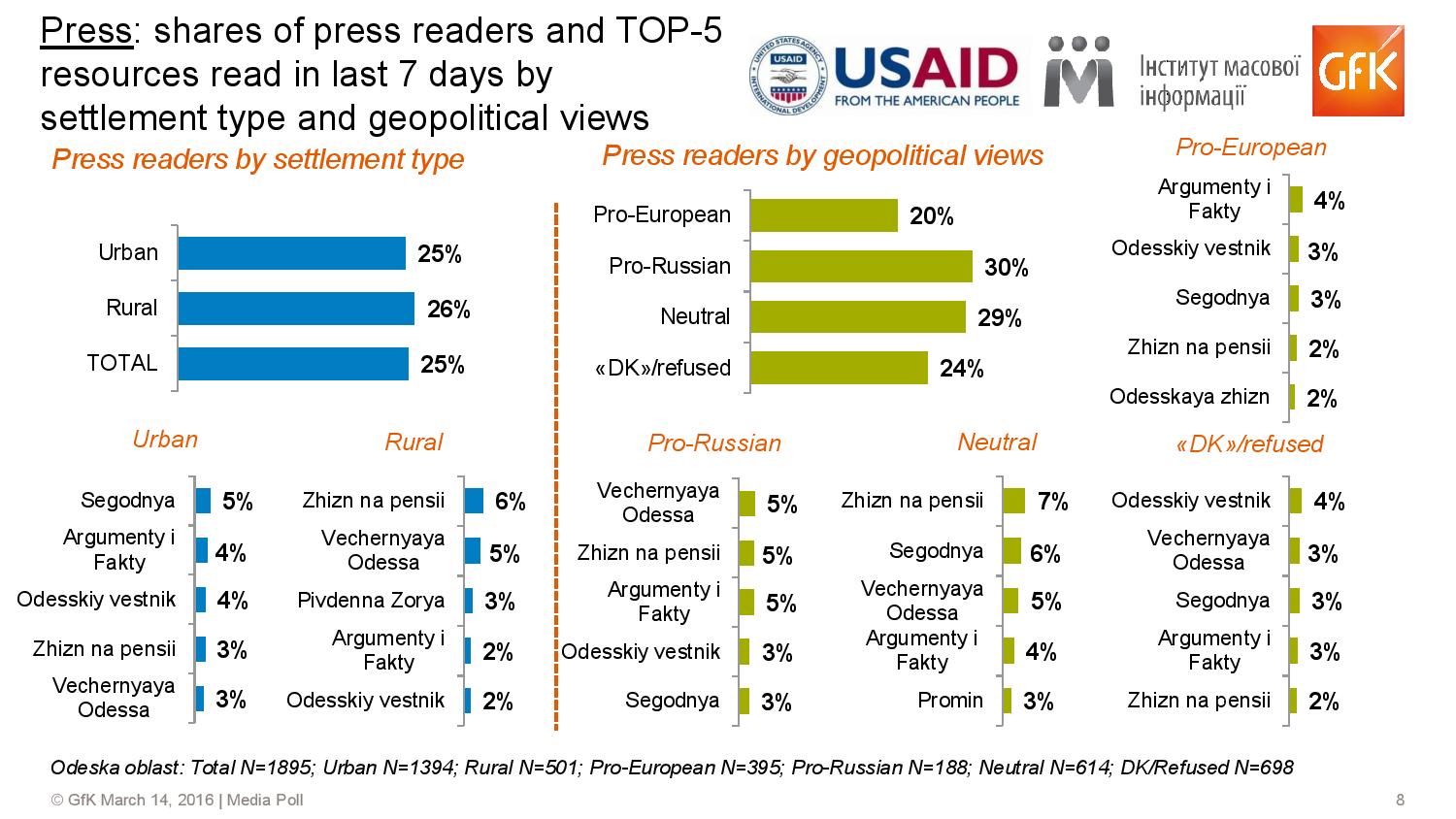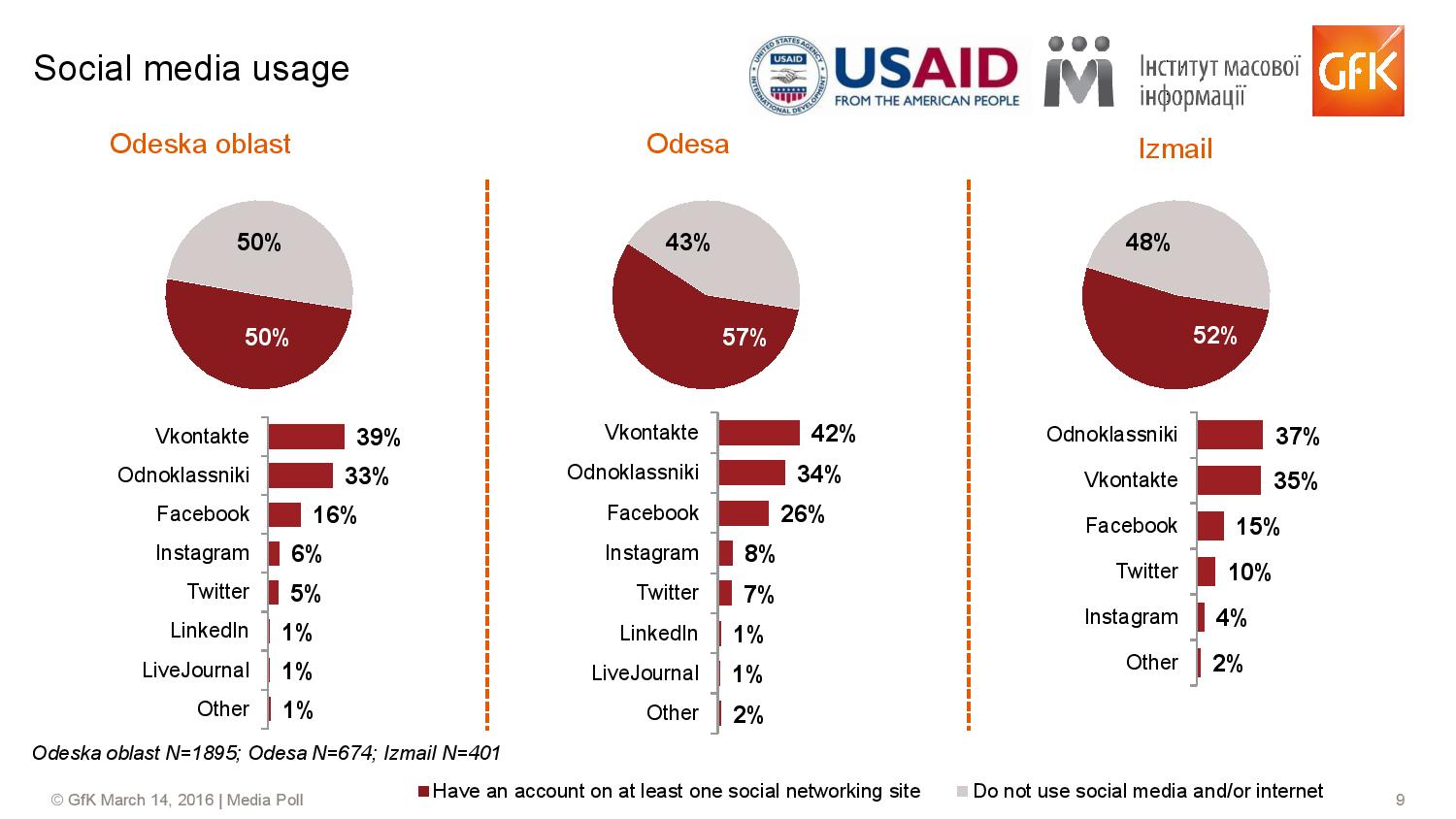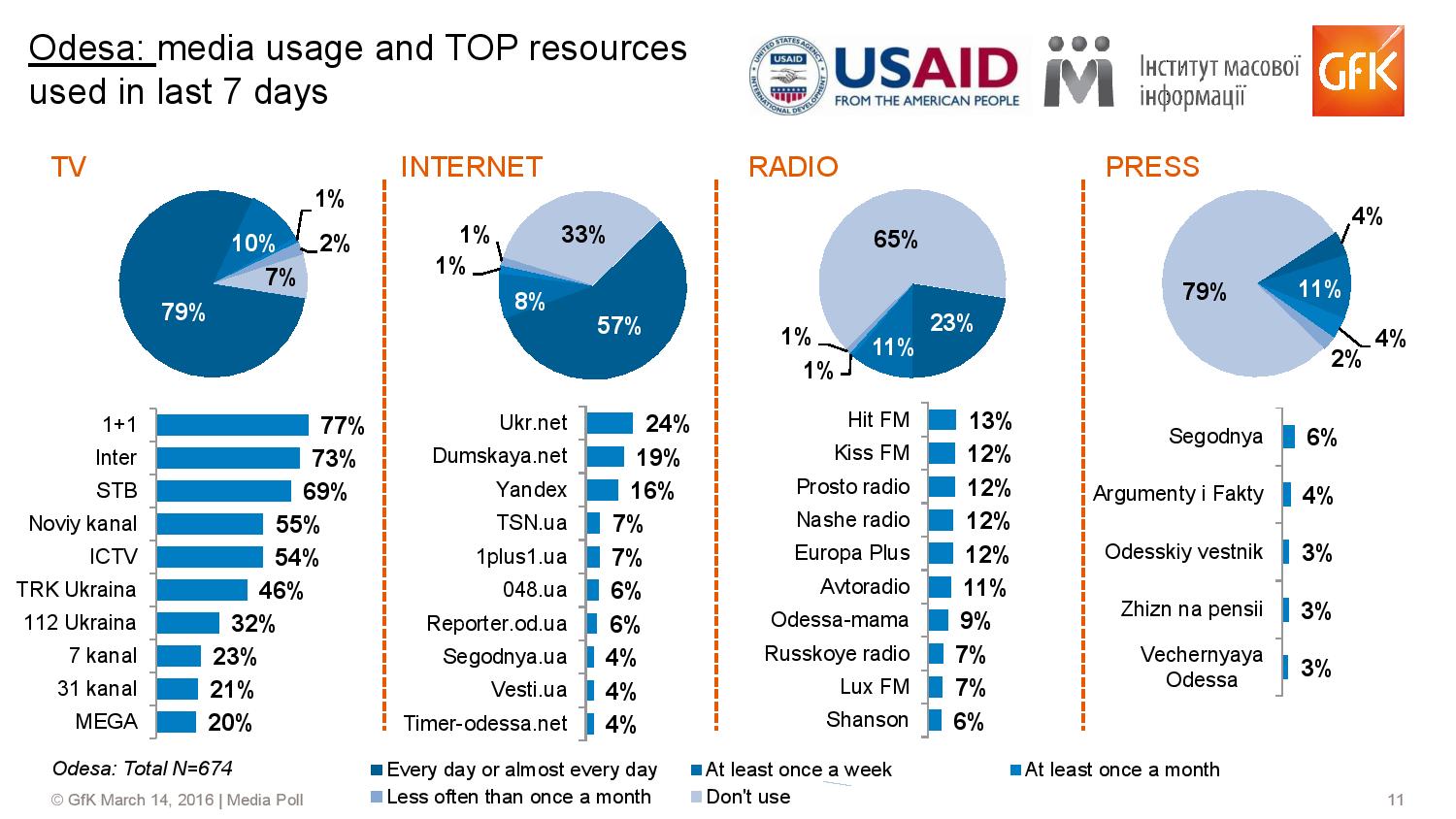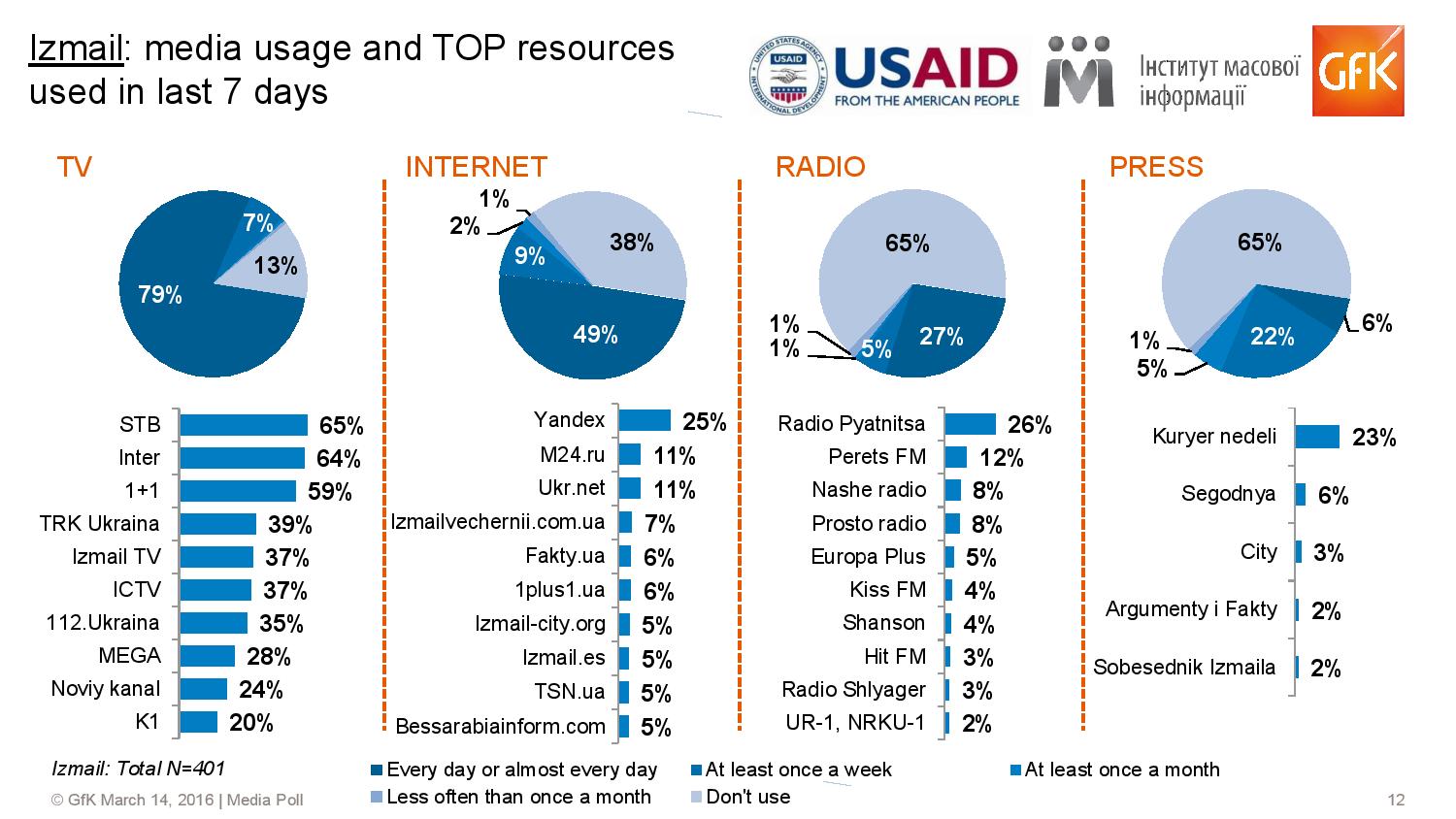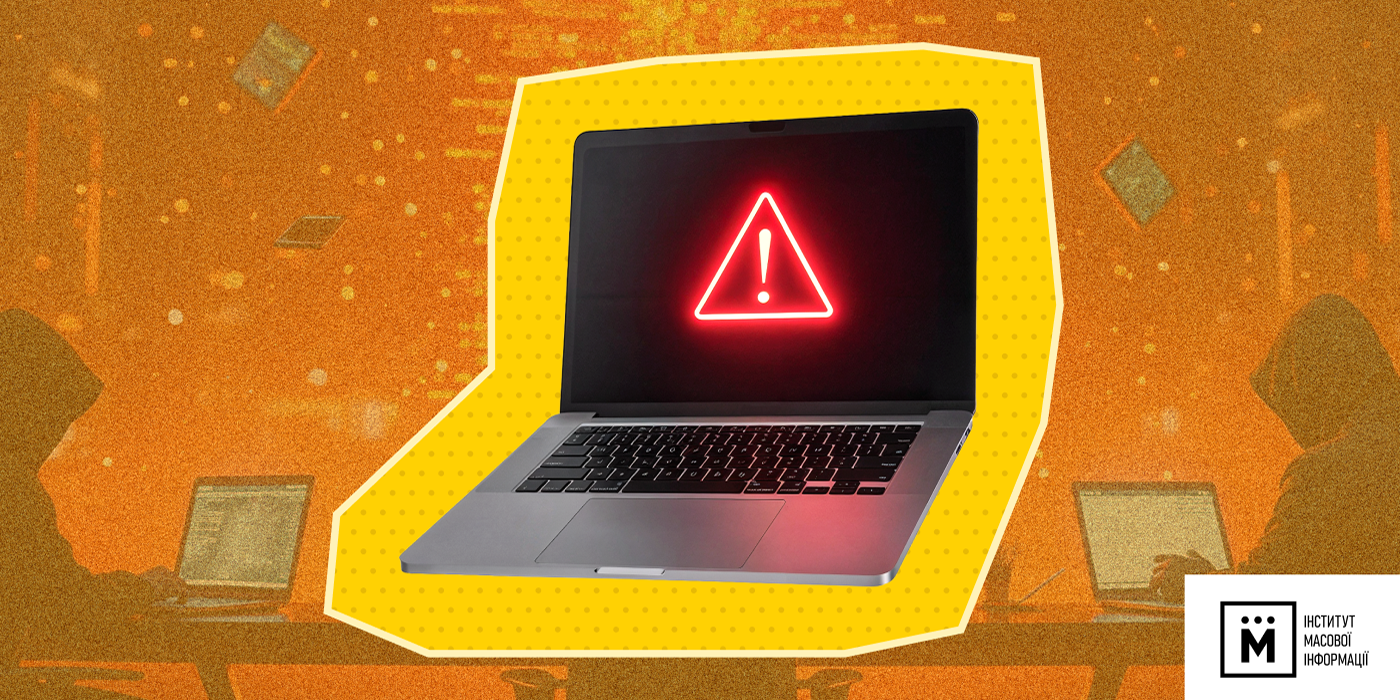Analysis by Institute of Mass Information
MAIN TENDENCIES OF MEDIA SPACE
Odesa is one of the three regions of Ukraine with the lowest level of freedom of press: many attacks against journalists are not investigated, and media outlets are mainly established for protecting one's business and political interests. These are the results of the study conducted by the Institute of Mass Information during September-November of 2015.
For more than one million of the population of Odesa, they have 550 officially registered printed editions, 40 regional TV companies and about 50 informational websites. The number of mass media outlets exceeds the same in any other oblast of Ukraine. For comparison, Poland has only just around 500 printed editions.
At the same time, according to the data of the National Council on issues of TV and Radio Broadcasting, only 27 of 40 registered TV companies conduct active airing and cable broadcasting. The situation with the newspapers is similar: not more than 20 are published on a regular basis and 28 local websites are regularly included into the regional feed of «Ukr.net» aggregator.
Almost every media outlet has public groups in social networks; some of them are even more popular than the mass media themselves (for example, «Mayak» (10,600 followers in FB, «Kulturometr» (10,900), and «Dumska» (almost 34,000, yet it is quite quiet there normally). There is one local public group, which is more popular compared to others, and even more popular than local online media –«Odessa, kak ona yest'» («Odesa as it is») (330,000 subscribers in Vkontakte). Pages of other local media outlets in social networks are more like business cards and platforms for promotion of the website's news.
One of the reasons for such variety is that the owners (in 90% of the cases, the owners are behind the scenes) of Odesa mass media outlets very reluctantly part with their relatively cheap assets, which can be easily «revived» for the elections periods. According to the data of the regional IMI representative, if someone by chance wants to buy such mass media, the owners would set unrealistically high prices, to the point where it is simpler and cheaper to create a new media outlet from scratch, and to finance it.
Due to the extremely swollen media market of Odesa, it has virtually no competition – both for advertisement, which could enable an independent journalist start-ups to develop, and for local topics.
MEDIA START-UPS
As of November of 2015, in Odesa there are three journalist start-ups, none of them is self-financing: they are financed at the cost of journalists who founded them.
Happymisto (website about modern city, urban studies, media). Its editor-in-chief Mykhailo Meizerskyi, and his partner in this project, Natalia Steblina is a professor at Odesa National University. The resource functions without external financing. The editorial office engages students of the journalism faculty, who are participants of various research projects and participate in contests.
Kulturometr – portal about the city’s cultural life. Its founders are a family couple, journalist and PR specialist Oksana Maslovata and photographer Mykola Vdovenko. The resource exists at the cost of its founders.
Yuzhnaya Stolitsa («Southern Capital») – tourism and culturology online newspaper about Odesa region. The founder is local journalist, Yulia Sushchenko, the resource exists at the cost of the founder and is not self-sustained.
LANGUAGE OF ODESA MEDIA OUTLETS
At local TV, more than 50% of weekly news programs are in Ukrainian; yet, the rest of TV programs are mainly in Russian. Local community television is 100% in Ukrainian, in addition, local community TV produces programs in Bulgarian, Moldavian and Gagauz.
As to press, the overwhelming majority of newspapers are in Russian, only two are in Ukrainian (namely, «Odeski Visti» and «Chornomorski novyny»). Other media outlets can print some materials in Ukrainian («Vechernyaya Odessa» – one page, «Odessakaya zhizn» – some articles, etc.). In the region, there is a newspaper in Bulgarian – «Roden Krai».
Over 90% of websites present their information in Russian, only one website is in Ukrainian, and only partly – Happymisto.
MEDIA OWNERSHIP STRUCTURE IN THE REGION
One of the key features of the media market of Odesa is the practice, where people engaged into politics, one way or another, found «temporary» controlled mass media. If later such media owner withdraws from the politics, the media outlet in question can be «frozen» until better times, as it happened to at least a dozen of local channels, or rented out or sold to other politicians. As a result, the local media market is extremely over-saturated, and normal competition among mass media outlets is severely undermined.
As of the end of 2015, media owners of Odesa had an unprecedently powerful influence on the editorial policy of the mass media outlets they control, taking into account the complicated situation in the economy of the country in general.
The key «players» at the media market of Odesa are former Party of Regions members, in particular, Serhiy Kivalov, who, according to the data of IMI regional representative, is the largest local owner of media outlets. The second place is held by media business of O.Kozyr, who is allegedly affiliated with Odesa’s current mayor, Henadiy Trukhanov, former Party of Regions member, who recently created his own party. Pro-governmental forces are also present at Odesa’s media market (for example, one of the most popular web resources of Odesa region, the website Dumskaya, is attributed to a notorious young politician, head of local Petro Poroshenko Bloc branch, Oleksiy Honcharenko).
In Odesa, the only region of all covered by the monitoring, there is an active pro-Russian influence in the media sphere. The sphere of Russian influence includes at least 4 websites, financed by Ihor Markov (leader of the pro-Russian party «Rodina», who vocally supported federalization of Ukraine. In August of 2015, he, together with other former high officials of Yanukovych’s presidency, founded in Moscow »Ukraine’s Rescue Committee», a media outlet speaking from the position of Russian propaganda).
RESULTS OF QUANTITATIVE ANALYSIS OF ODESA MEDIA
One of the key problems of Odesa media market is publication of commissioned stories without marking, or without «proper marking» (as stipulated by the Law «On advertisement»). During the monitoring period, the percentage of such materials in printed press was 21% from the total number of materials published, but in some media outlets, such as the newspaper «Slovo», the percentage of «dzhynsa» was as high as 60%. In online media outlets, this indicator is considerably lower – 7% from the total number of materials have features of being commissioned, yet this difference is due to a much larger number of published materials in online media outlets, as in them, the number of materials is not limited by the number of pages, like it does in printed press. The lowest percentage of commissioned stories is on TV – 3% from the total number of news in weekly news programs.
The share of socially relevant materials on local topics in printed media outlets was only 24% from the total number of published materials, and is close to the level of commissioned stories in the same media outlets, but it should have constituted the bulk of content in local media. At that, of these 24%, more than one third is local news about crimes or local political events, the latter often presented in a biased manner.
At the same time, online media are much more oriented to their local audience: the indicator of socially relevant materials of local importance here was 37% from the total number of published materials. The highest percentage on this specific indicator was registered on TV: 73% of all broadcast materials cover local issues.
RESULTS OF QUALITATIVE ANALYSIS OF ODESA MEDIA
Mass media of Odesa, in fact, ignore the topic of the armed conflict in the East. Printed media outlets publish only 3% of materials on this topic, online media have even worse indicators – this issue is covered only in 1% of materials. The highest indicator is on television – 13% of materials cover the conflict or discuss problems related to it.
As of the end of 2015, Odeska oblast accepted over 30 thousand internally displaced persons. In spite of this fact, local mass media outlets pay virtually no attention to the problems of these people, who found themselves in complicated circumstances and need support. In printed press, for example, only 1% of materials was related to IDPs; in online media outlets, the share of such materials was close to zero. TV again shows the highest percentage – 5% of materials from total number of news in weekly news programs were dedicated to the problems of IDPs. Still, the mere presence of such materials does not mean they all were of high quality. Sometimes, the materials were instigating negative attitudes in the locals. For example, in the story «Gypsy camp in Kulikovo Polie» (as of Sep. 18, 2015) on the «Pervyi Gorodskoi» («First City [Channel]») channel was about the Roma IDPs from the ATO zone, yet the journalist focused attention on these people’s aggressiveness and, moreover, she used the name «Gypsies» three times, which is not exactly a neutral terminology.
Instead, the share of «no-legwork» materials (advertising local authorities without any journalist processing) in Odesa mass media is quite high. The highest percentage was registered in online media – 16% from all materials. For example, the experts noted the story dedicated to the Emergency Response Worker Day, where the material was complimentary to the local emergency response service, and said nothing about the institution’s problems, for example, the problems that exacerbated after fighting the fire at Vasylkiv Oil Base. In addition, the footage was taken based on the same scenario as they did in Dnipropetrovsk.
Mass media outlets of Odesa practically do not cover the problems of local housing support services (activities of the aggregate of services that are needed for normal housing and offices, issues of local water, gas, heat, electricity supply, local public transportation) – during the monitoring period, only 3% of the total number of materials were dedicated to this problem. The same level of coverage was dedicated to activities of local activists and NGO initiatives – only 3% from the total number of local news.
Qualitative content analysis of Odesa mass media showed that in printed press only one quarter of the materials are complete, and less than half of the materials are balanced (45%). In general, adherence to journalist standards of local printed mass media outlets, according to evaluation of IMI experts, was rated 3.65 points out of possible 6 (for comparison, based on IMI research, the general national rating for journalist standards adherence in printed press was the average 4.5 out of 6). Online media outlets showed a higher level of standard adherence; in total, they received 4.77 points out of 6 possible (which is also lower by as much as a point compared to the rating of online media in the country in general, according to IMI research). Approximately one half of the materials in the online media outlets of Odesa are incomplete and unbalances.
The highest rating for adherence to standards was granted to the TV of Odesa (weekly news programs) – 5.12 points. Yet, it should be noted that 40% of analyzed materials were incomplete, and 20% were unbalanced; at this, there were no violations related to promptness and validity of the materials.
ASSESSMENT OF SITUATION BY LOCAL JOURNALISTS
IMI survey of Odesa journalists (14 local journalists from various types of mass media outlets filled in the questionnaires offered by IMI) showed that in the media community itself the level of trust to the content is quite low; the main problems named by respondents were laziness, low qualification of journalists, pressure from owners, corruptibility of journalists, few unbiased experts available and too many media outlets on the market. 100% of journalists surveyed in Odesa have a very questioning attitude to news, and comment that one «needs skill to read» the news and to understand for what they were published. All respondents mentioned that the local news from Odesa proper are abundant, but regional news are lacking – there is practically no information about what is happening in the oblast around Odesa. The journalists also complain about absence of interaction between them and local authorities, and mention separately low professionalism of press services.
As to the sources of information – the journalists receive 50% of information from their colleagues, 25% – from social networks Vkontakte and Facebook, 10% – from press services, 10% – via personal contacts, and 5% – via press announcements and press releases.
90% of the surveyed journalists mentioned that the topics are selected for them by editors, and for this reason they consider themselves «universal journalists», and cannot go too deeply into any particular topic they are interested in. The journalists think that this situation is caused by limited staff of media outlets and greed of the owners, who do not wish to hire new journalists with certain specialization (for example, who would write only about the economy, or about the activities of the city council, etc.). Among the problems that the local mass media outlets face are low level of communication and few reliable unbiased experts. The journalists mostly were complaining about the editors’ influence, about coverage of local news, and even shared the special «formula»: there are three types of events and people 1. white – about those you are supposed to write only positive things; 2. grey – neutral coverage; 3. black – these simply do not exist. Practically all local journalists admitted that they practice self-censorship.
Odesa journalists think that the main problem of one-sided presentation of information in local mass media is old staff members, who are accustomed to working «in a Soviet way». The journalists admitted that they are quite indifferent to all events that take place in the city.



